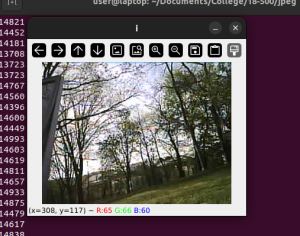As you’ve designed, implemented and debugged your project, what new tools or new knowledge did you find it necessary to learn to be able to accomplish these tasks? What learning strategies did you use to acquire this new knowledge?
I had to learn about the specifics of ESP32 development. The toolchain and configurations methods were all new to me. Along with that I also had to learn about the intricacies of how Wi-Fi worked on the ESP32s and how to debug them when the performance wasn’t were we wanted it. I mostly learned by reading the espressif programming manual and the provided example code. It also helped that I could learn by drawing from on my previous class work and work with microcontrollers to help me along.
What did you personally accomplish this week on the project?
For this week, I used a multimeter to check the power consumption of the ESP-32 to verify the claimed values on its data sheet. I got a measurement of 1.5W maximum power draw for the remote camera node. This was with the camera continuously transmitting imagery which is an absolute worst case situation. The average power draw was more around the range of 1w which is inline with our initial assumptions based on the manufacturer’s datasheet. The power consumption for the remote camera node was also measured and it was slightly lower at only about 0.8w maximum.
I got the change detector running on the ESP-32. The change detector is implemented as a separate task than the main sending task so it doesn’t block the main sending task. Since the ESP32 has two cores these two tasks are able to be run simultaneously to provide maximum performance. The change detector works by computing the number of pixels that have had significant changes. If the number is above a threshold then change is assumed to have happened and video streaming will commence.
I also got all 6 camera nodes sent to the central node at the same time. I checked the SPI output with a logic analyzer to verify the data and the frame spacings. Even with 6 nodes, the system is able to reliably deliver frames at 100ms intervals with only slight variations. The SPI clock rate was also bumped up to 20MHz to account for the time needed to decode the image on the FPGA side
Finally, I also got a range test completed for the remote camera nodes sending to the central node. The current system with omnidirectional antennas is able to hit the targeted 50m while maintaining a stable 10fps stream. The range test was done in Schenley park to simulate the system being used in an outdoor environment. For the test, the remote node was mounted to a small tree and I walked slowly away with the central node. I stopped walking when the video stream stopped working consistently


Is your progress on schedule or behind? If you are behind, what actions will be taken to catch up to the project schedule?
Currently on schedule
What deliverables do you hope to complete in the next week?
For next week, I hope complete final integration with Varun’s FPGA with the new stream addressing system schema
